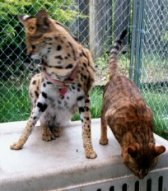
Pasteurella is a small, nonmotile, Gramnegative, ovoid bacterial rod. The organism is a parasite of the oral cavity of many species of animals, including felines. Pasteurella was isolated from the oral cavity and upper respiratory tract of 60 to 75% of normal felines. The rate of isolation is higher from animals with dental tartar and gingival disease than from animals with clean teeth.

Pasteurella is most frequently isolated as a facultative anaerobe along with other bacteria from infected wounds and abscesses in felines. It has also been isolated from infections of the external ear canals, conjunctiva, nasal passages and sinuses, tooth root abscesses, periodontal infections and surgical wounds. Pasteurella species are frequent secondary invaders in cats with primary viral pneumonia.
Pasteurella organisms enter tissues by licking of wounds or bites. Organisms are frequently isolated from the claws of cats, but cat scratches are less apt to be associated with infections than bites.

Treatment is to clean a fresh wound. Closed infections should be opened to allow drainage and then cleansed periodically until drainage ceases and the wound begins to heal. Systemic antibiotics are an important part of treatment and should be given for 5-10 days. Feline isolates of Pasteurella multocida are most sensitive to tetracycline and chloramphenicol, only moderately sensitive to penicillin and less resistant to sulfas. Trimethoprim-sulfonamides are effective for treatment of Pasteurella respiratory infections.
Pasteurella infections in cats are interesting in 2 ways. First, cats seem resistant to the septicemic forms of pasteurellosis that are common in other species. Second, cats are notorious carriers of pathogenic strains of Pasteurella. Pasteurella species are transmitted from cat to cat almost exclusively by bites. Therefore, affected cats are not a hazard to other cats. I have talked to my vet about treatment, and she feels it is not a good use of my money.
Pasteurellosis is probably the most common zoonotic disease passed from animal to people. Pasteurellosis exists in people in two clinical forms: localized infection caused by an animal bite, and a systemic form manifested variably as sinusitis, pneumonia, bacteremia or brain abscess. The origin of P moltocida in the systemic form is usually unknown, though many affected people have a history of animal exposure.
Localized pasteurellosis in people occurs at the site of the bite, usually in soft tissues of the hand. Joint infections can be a serious consequence of bites that penetrate into the synovial spaces. The wound becomes painful and inflamed within a few hours. The infection spreads rapidly to surrounding tissues and along lymphatics to the regional lymph notes. The most common local complications are abscess formation and tenosynocitis. The condition is most severe after the first bite; subsequent bites are less likely to become infected. Wounds should be cleansed as soon as possible. Soaking the wound and applying a drawing salve is recommended. If pain, redness and swelling begin to develop at the site after a few hours, medical attention should be sought as soon as possible. The effective treatment in humans is augmentin. Pasteurellosis is not to be taken lightly. A small puncture wound that you would just wash and go about your business is the one that needs your attention.
In closing, the diet of your animal has nothing to do with the bacteria. The wound is tiny but the pain is mighty.
Information has been gather from: Common Infectious Diseases of Multiple-Cat Environments, Zoo Medicine, Mammals in Captivity, Kaiser Emergency room doctors and nurses, and my vet Andresen Animal Clinic

If you would like to contact us:Cocoa
Home (Home Index)